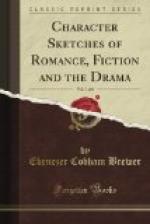ANACHRONISMS. (See ERRORS.)
CHAUCER, in his tale of Troilus, at the siege
of Troy, makes
Pandarus refer to Robin Hood.
And to himselfe ful soberly he saied,
From hasellwood there jolly Robin plaied.
Book v.
GILES FLETCHER, in Christ’s Victory, pt. ii. makes the Tempter seem to be “a good old hermit or palmer, travelling to see some saint, and telling his beads!!”
LODGE, in The True Tragedies of Marius and Sylla (1594), mentions “the razor of Palermo” and “St. Paul’s steeple,” and introduces Frenchmen who “for forty crowns” undertake to poison the Roman consul.
MORGLAY makes Dido tell AEneas that she should have been contented with a son, even “if he had been a cockney dandiprat” (1582).
SCHILLER, in his Piccolomini, speaks of lightning conductors. This was about 150 years before they were invented.
SHAKESPEAKE, in his Coriolanus (act ii. sc. 1), makes Menenius refer to Galen above 600 years before he was born.
Cominius alludes to Roman Plays, but no such things were known for 250 years after the death of Cominius.—Coriolanus, act ii. sc. 2.
Brutus refers to the “Marcian Waters brought to Rome by Censorinus.” This was not done till 300 years afterwards.
In Hamlet, the prince Hamlet was educated at Wittemberg School, which was not founded till 1502; whereas Saxo-Germanicus, from whom Shakespeare borrowed the tale, died in 1204. Hamlet was thirty years old when his mother talks of his going back to school (act i. sc. 2).
In 1 Henry IV., the carrier complains that “the turkeys in his pannier are quite starved” (act ii. sc. 5), whereas turkeys came from America, and the New World was not even discovered for a century after. Again in Henry V., Grower is made to say to Fluellen, “Here comes Pistol, swelling like a turkey-cock” (act v. sc. 1).
In Julius Caesar, Brutus says to Cassius, “Peace, count the clock.” To which Cassius replies, “The clock has stricken three.”
Clocks were not known to the Romans, and striking-clocks were not invented till some 1400 years after the death of Caesar.
VIRGIL places AEneas in the port Velinus, which was made by Curius Dentatus.
This list, with very little trouble, might be greatly multiplied. The hotbed of anachronisms is mediaeval romance; there nations, times and places, are most recklessly disregarded. This may be instanced by a few examples from Ariosto’s great poem, Orlando Furioso.
Here we have Charlemagne and his paladins joined by Edward king of England, Richard earl of Warwick, Henry duke of Clarence, and the dukes of York and Gloucester (bk. vi.). We have cannons employed by Cymosco king of Friza (bk. iv.), and also in the siege of Paris (bk. vi.). We have the Moors established in Spain, whereas they were not invited over by the Saracens for nearly 300 years after Charlemagne’s death. In bk. xvii. we have Prester John, who died in 1202; and in the last three books we have Constantine the Great, who died in 337.




